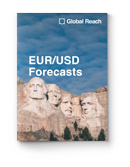Euro to Dollar Rate Eyes Break of 1.10 in Wake of U.S. Inflation: City Index
- Written by: Fawad Razaqzada, Analyst at City Index
-

Image © Adobe Images
The FX markets had been quite quiet as traders sat on their hands ahead of this week’s most important macro data – the U.S. Consumer Price Index.
Well, the data didn’t disappoint in terms of market reaction – unless you were a dollar bull.
In response to a weaker headline print, traders sold the dollar and bought gold, silver and bonds.
Stock index futures and crude oil also jumped. The EUR/USD neared 1.10.
The EUR/USD has been printing higher lows ever since it held key support around 1.05 in early March. The single currency’ ascend has been nice and steady.
With the price holding above the 21-day exponential moving average and key support at around 1.0800, the path of least resistance remains to the upside and so it remains on track to climb above the February high of 1.1033 soon.
Image courtesy of City Index.
The weaker CPI print has raised doubts over whether the Fed will now hike rates at all next month, after a 25bp hike was priced in with a 75% probability for the May 3 FOMC meeting.
Now, that probability has fallen to around 66%, suggesting investors feeling that the Fed is near the end of the hiking cycle will feel even more comfortable now.
Until Friday’s stronger non-farm payrolls report, the trend for US data has been negative surprises and the market has correspondingly been repricing lower the Fed’s projected interest rate path.
This repricing caused a significant downward move in the dollar until the NFP data provided the greenback with some relief.
Live EUR/USD Money Transfer Exchange Rate Checker | ||
Live Market Rate: | get quick quote | |
Corpay: | ||
Banks: Median Low | ||
Banks: Median High | ||
These data are based on the spread surveyed in a recent survey conducted for Pound Sterling Live by The Money Cloud. | ||
The market will continually question whether more rate hikes are forthcoming, which is why a lot of attention was on the CPI release today.
The market’s immediate response seems to be that we are now a lot closer to the peak in terms of interest rate hikes, now that inflation has cooled to 5.0% year-over-year in March, thus continuing its trend of weakening price pressures.
The 5% reading on the headline front was weaker than the 5.2% expected, and down sharply from the 6.0% recorded the month before. Core inflation came in as expected, however, edging higher to 5.6% from 5.5% previously.
I suppose the fact that core CPI rose is something that will prevent the dollar from falling significantly further.
What’s more, it was energy's decline that was the biggest annual deflationary driver for the headline CPI print, but with crude oil climbing back above $80 a barrel in light of OPEC’s surprise decision last week, this could provide a fresh inflation jolt in the months ahead.
EUR/USD Forecasts Q2 2023Period: Q2 2023 Onwards |
For now, traders will be happy to see headline inflation falling, which should keep the dollar under pressure for a while.
Meanwhile, there will be more inflation data on Thursday in the form of PPI.
However, the latter is not going to be as important as CPI, I don’t think.
Now that we have seen inflation falling to 5%, investors' focus will turn to the FOMC's last meeting minutes, due for release later in the day.
A bit of profit-taking on the dollar shorts might be expected.
The minutes will reveal some of the Fed's thinking behind the 25bp hike in March, amidst the banking crisis.
If the minutes reveal concrete signs that the central bank is very close to a peak in interest rates, or policymakers confirm market expectations of cutting interest rates later in the year if needed, then this would likely be seen as dollar-negative.
There’s more data to come on the last day of the week, which should keep FX traders busy.
Retail Sales Due on Friday
The Fed’s rate projections have been cut sharply in recent weeks owing to weakness in U.S. data and signs of peak inflation.
Worries over the health of U.S. consumers will intensify if we see a weaker print in either retail sales or consumer confidence, especially as they are going to feel the impact of higher gasoline prices in light of OPEC’s decision to sharply cut crude production.
Both headline and core retail sales are seen falling 0.4% month-over-month.
The University of Michigan’s consumer confidence index is a more forward-looking indicator of consumer health and may thus trigger a sharper move in the dollar should we see a bigger-than-expected deviation from the expected 62.0 reading.
Fawad Razaqzada is an Analyst at City Index





